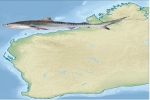Thermal tolerance and hypoxia tolerance are associated in blacktip reef shark neonates
Thermal tolerance and hypoxia tolerance are associated in blacktip reef shark (Carcharhinus melanopterus) neonates Ian A. Bouyoucos, Phillip R. Morrison, Ornella C. Weideli, Eva Jacquesson, Serge Planes, Colin A. Simpfendorfer, Colin J. Brauner, Jodie L. Rummer ABSTRACT: Thermal dependence of growth and metabolism can influence thermal preference and tolerance in marine ectotherms, including threatened and
First records of the seven‐gilled and six‐gilled sharks found in the Galápagos Marine Reserve
First records of the seven‐gilled Notorynchus cepedianus and six‐gilled Hexanchus griseus sharks (Chondrichthyes: Hexanchiformes: Hexanchidae) found in the Galápagos Marine Reserve Salome Buglass, Shannon Nagy, David Ebert, Paulina Sepa, Alan Turchik, Katherine L. C. Bell, Fernando Rivera, Jonatha Giddens ABSTRACT: This study reports the first records of cowsharks (Hexanchidae) in the Galápagos Islands, in particular
Why the Kanak Don’t Fear Sharks
Why the Kanak Don’t Fear Sharks: Myths as a Coherent but Dangerous Mirror of Nature Eric Clua, Jean Guiart ABSTRACT: This study focuses on the important role of sharks in the Melanesian mythology. Based on unpublished stories essentially originating from New Caledonia, we show how strong the links are between myths and the physical environment
Lemon sharks – live fast, die young
News Release Leibniz-Institute of Freshwater Ecology and Inland Fisheries (IGB) 29. July 2020 — — — — — — — Risk-taking individuals are expected to grow better but also die faster than the less explorative individuals. Such trade-offs can maintain multiple phenotypes in a population by allowing individuals with different behavioural strategies to achieve comparable
Personality‐driven life history trade‐offs differ in two subpopulations of free‐ranging predators
Personality‐driven life history trade‐offs differ in two subpopulations of free‐ranging predators Félicie Dhellemmes, Jean‐Sébastien Finger, Matthew J. Smukall, Samuel H. Gruber, Tristan L. Guttridge, Kate L. Laskowski, Jens Krause ABSTRACT: Consistent individual differences in behaviour (i.e. personality) can be explained in an evolutionary context if they are favoured by life history trade‐offs as conceptualized in
The effects of digesting a urea-rich meal on North Pacific spiny dogfish
The effects of digesting a urea-rich meal on North Pacific spiny dogfish (Squalus acanthias suckleyi) J. Lisa Hoogenboom, Alyssa M. Weinrauch, Chris M. Wood, W. Gary Anderson ABSTRACT: Marine elasmobranchs are nitrogen-limited owing to the requirement of nitrogen for both somatic growth and urea-based osmoregulation, and due to the loss of urea across the gills
New mode of oviparous reproduction in sharks
Discovery of a new mode of oviparous reproduction in sharks and its evolutionary implications Nakaya, K., White, W.T. & Ho, H. ABSTRACT: Two modes of oviparity are known in cartilaginous fishes, (1) single oviparity where one egg case is retained in an oviduct for a short period and then deposited, quickly followed by another egg
Microplastics in demersal sharks of the North-East Atlantic
Investigating the presence of microplastics in demersal sharks of the North-East Atlantic Kristian J. Parton, Brendan J. Godley, David Santillo, Muhammad Tausif, Lucy C. M. Omeyer, Tamara S. Galloway ABSTRACT: Microplastic pollution is ubiquitous in the marine environment and is ingested by numerous marine species. Sharks are an understudied group regarding their susceptibility to microplastic
Global status and conservation potential of reef sharks
Global status and conservation potential of reef sharks MacNeil, M.A., Chapman, D.D., Heupel, M. et al. ABSTRACT: Decades of overexploitation have devastated shark populations, leaving considerable doubt as to their ecological status1,2. Yet much of what is known about sharks has been inferred from catch records in industrial fisheries, whereas far less information is available
Identification of a nursery area for the critically endangered hammerhead shark
Identification of a nursery area for the critically endangered hammerhead shark (Sphyrna lewini ) amid intense fisheries in the southern Gulf of Mexico G.A. Cuevas‐Gómez, J.C. Pérez‐Jiménez, I. Méndez‐Loeza, M. Carrera‐Fernández, J.L. Castillo‐Géniz ABSTRACT: Since the 1980s, there has been growing concern in the Mexican Atlantic regarding high catches of neonate and juvenile sharks in
Beach-user perceptions and attitudes towards drone surveillance as a shark-bite mitigation tool
Beach-user perceptions and attitudes towards drone surveillance as a shark-bite mitigation tool Debra Stokes, Kirin Apps, Paul A. Butcher, Betty Weiler, Hanabeth Luke, Andrew P. Colefax ABSTRACT: Management of human-wildlife conflict is often challenging and complex, particularly when the conflict involves sharks. New technologies are being trialled in New South Wales, on Australia’s east coast,
Cause for optimism over non-reef shark numbers off North West WA
Media Release Department of Fisheries, Western Australia 29. July 2020 — — — — — — — — — Reliable information for population assessments is rare for sharks, but fisheries researchers from the Department of Primary Industries and Regional Development (DPIRD) have been building a data rich study of non-reef species since 2002. The latest
Biodiversity and conservation of marine elasmobranchs in the extreme south of the Brazil
Biodiversity and conservation of marine elasmobranchs in the extreme south of the Brazil, Southwestern Atlantic Luiza de David Chelotti, Paulo Roberto Santos dos Santos ABSTRACT: The extreme south of Brazil, Southwestern Atlantic, presents a vast and interesting history of elasmobranchs occurrence records. This is a transition zone between warm tropical waters cold regions, which reflects
Elasmobranch Community Dynamics in Florida’s Southern Indian River Lagoon
Elasmobranch Community Dynamics in Florida’s Southern Indian River Lagoon Grace Roskar, Michael P. McCallister, Adam M. Schaefer, Matthew J. Ajemian ABSTRACT: Many elasmobranch species utilize estuaries as nurseries, parturition areas, and foraging grounds. Florida’s Indian River Lagoon (IRL), an “estuary of national significance,” has experienced many anthropogenic impacts in recent decades, such as habitat degradation
Drone imaging of elasmobranchs
Drone imaging of elasmobranchs: Whale sharks and golden cownose rays co-occurrence in a zooplankton hot-spot in southwestern Sea of Cortez Martín G.Frixione, Miguel de J .Gómez García, Marco F.W. Gauger ABSTRACT: The golden cownose ray (Rhinoptera steindachneri) and the whale shark (Rhincodon typus) are two elasmobranch species commonly found in Bahía de La Paz, Baja





